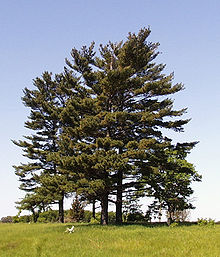
Back صنوبر ستروبوس ARZ Veymutov şamı Azerbaijani وئیموت شامی AZB Хвоя веймутава Byelorussian Pinus strobus Catalan Pinus strobus CEB Borovice vejmutovka Czech Pinwydden wen Welsh Weymouth-fyr Danish Weymouth-Kiefer German
| Pinus strobus | |
|---|---|

| |
| Pinus strobus group | |
| Scientific classification | |
| Kingdom: | Plantae |
| Clade: | Tracheophytes |
| Clade: | Gymnospermae |
| Division: | Pinophyta |
| Class: | Pinopsida |
| Order: | Pinales |
| Family: | Pinaceae |
| Genus: | Pinus |
| Subgenus: | P. subg. Strobus |
| Section: | P. sect. Quinquefoliae |
| Subsection: | P. subsect. Strobus |
| Species: | P. strobus
|
| Binomial name | |
| Pinus strobus | |
Pinus strobus, commonly called the eastern white pine, northern white pine, white pine, Weymouth pine (British), and soft pine[2] is a large pine native to eastern North America. It occurs from Newfoundland, Canada, west through the Great Lakes region to southeastern Manitoba and Minnesota, United States, and south along the Appalachian Mountains and upper Piedmont to northernmost Georgia and perhaps very rarely in some of the higher elevations in northeastern Alabama.[3] It is considered rare in Indiana.[4]
The Haudenosaunee maintain the tree as the central symbol of their multinational confederation, calling it the "Tree of Peace",[5] where the Seneca use the name o’sóä’[6] and the Kanienʼkehá:ka call it onerahtase'ko:wa.[7] Within the Wabanaki Confederacy, the Mi'kmaq use the term guow to name the tree,[8] both the Wolastoqewiyik and Peskotomuhkatiyik call it kuw or kuwes,[9] and the Abenaki use the term kowa.[10]
It is known as the "Weymouth pine" in the United Kingdom,[11] after Captain George Weymouth of the British Royal Navy, who brought its seeds to England from Maine in 1605.[12]
- ^ Farjon, A. (2013). "Pinus strobus". IUCN Red List of Threatened Species. 2013: e.T42417A2978687. doi:10.2305/IUCN.UK.2013-1.RLTS.T42417A2978687.en. Retrieved 19 November 2021.
- ^ Carey, Jennifer H. (1993). "Pinus strobus". Fire Effects Information System (FEIS). US Department of Agriculture (USDA), Forest Service (USFS), Rocky Mountain Research Station, Fire Sciences Laboratory. Retrieved 12 August 2013.
- ^ USDA, NRCS (n.d.). "Pinus strobus". The PLANTS Database (plants.usda.gov). Greensboro, North Carolina: National Plant Data Team. Retrieved 22 January 2018.
- ^ "Plants Profile for Pinus strobus (eastern white pine)". www.plants.usda.gov. Archived from the original on 2020-08-28. Retrieved 2020-10-07.
- ^ Graymont, Barbara (2009). The Iroquois. Infobase Publishing. p. 21.
The tree had four symbolic roots, the Great White Roots of Peace, spreading north, east, south, and west. If any other nation ever wished to join the League, it would have to follow the White Roots of Peace to the source and take shelter beneath the tree. Atop the tree, he placed an eagle to scream out a warning at the approach of danger. He symbolically planted the tree in the land of the Onondagas, the place of the Grre, the confederate lords, or peace chiefs, would sit beneath it and be caretakers of the Great Peace.
- ^ Chafe, Wallace (2015). A Grammar of the Seneca Language (PDF). University of California Press. p. 18. ISBN 978-0-520-28641-2.
- ^ "Mohawk Basic Knowledge". Retrieved 10 September 2023.
- ^ "Pine". Mi'gmaq-Mi'kmaq Online Dictionary. Listuguj. Retrieved 10 September 2023.
- ^ Francis, Kmihqitahaman David A.; Newell, Kmihqitahaman-ona Wayne A. "Passamaquoddy-Maliseet Language Portal". Retrieved 10 September 2023.
- ^ "White Pine". Western Abenaki Dictionary. Retrieved 10 September 2023.
- ^ Moore, Gerry; Kershner, Bruce; Craig Tufts; Daniel Mathews; Gil Nelson; Spellenberg, Richard; Thieret, John W.; Terry Purinton; Block, Andrew (2008). National Wildlife Federation Field Guide to Trees of North America. New York: Sterling. p. 77. ISBN 978-1-4027-3875-3.
- ^ Little, Elbert L. (1980). "Eastern White Pine". National Audubon Society Field Guide to North American Trees: Eastern Region. New York, New York: Alfred A. Knopf. p. 296.
